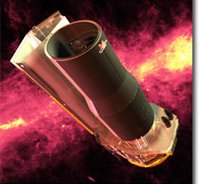
Two independent scientific groups have recently reported the first spectroscopy of planets orbiting other stars, using the Spitzer Space Telescope. The planets (HD 209458b and HD 189733b) are “hot Jupiters” orbiting within 0.05 AU of solar-type stars, and with orbital periods from 2.2 to 3.5 days. Their orbital planes are close to our line of sight, so both planets pass in front of (“transit”), and disappear behind their stars, once each orbit. The Spitzer measurements were made by subtracting the spectrum of each star – with the planet in eclipse – from the combined infrared light of the system, to yield the infrared spectrum of the planet alone. Theorists expected that absorption by hot water vapor would dominate the spectra of these planets in the 7- 14-micron wavelength region. However, neither planet shows this expected signature, indicating that some process is masking the water absorption. One planet (HD 209458b) shows spectral features appearing in emission above a hot thermal continuum, indicating the likely presence of silicate clouds, and possibly more exotic compounds, at high altitudes in the planet’s atmosphere.
The future launch of the James Webb Space Telescope will allow us to extend these measurements to spectra of transiting terrestrial planets in the habitable zones around lower main sequence stars.
 A Talk With Jim Green
A Talk With Jim Green What Can Extant Genomes Reveal About Early DNA Metabolism?
What Can Extant Genomes Reveal About Early DNA Metabolism? What We Talk About When We Talk About Earth's Oxygenation
What We Talk About When We Talk About Earth's Oxygenation Bowling With Astrobiologists: A Twisted Path Toward the Origin of DNA
Bowling With Astrobiologists: A Twisted Path Toward the Origin of DNA